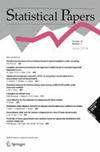混合试验中Dirichlet分布的空间填充设计
IF 1.1
3区 数学
Q2 STATISTICS & PROBABILITY
引用次数: 0
摘要
均匀设计广泛用于混合试验。设计点的均匀性通常用差异准则来评价。本文提出了一种新的测量设计点分布与狄利克雷分布之间偏差的判据。Dirichlet分布的支持是由d维向量的集合定义的,这些向量的项是区间[0,1]内的实数,使得坐标的和等于1。该支架适用于混合实验。根据其参数的不同,狄利克雷分布允许对称或不对称、均匀或更集中的点分布。用Kullback-Leibler散度来评价经验分布与目标分布之间的差异。我们使用两种方法来估计散度:插件估计和最近邻估计。所得的两个准则用于建立混合试验的空间填充设计。在平坦狄利克雷分布的特殊情况下,两个准则都会导致均匀的设计。将它们与现有的均匀性标准进行比较。新标准的优点是,除了一致性之外,它们允许其他分布,而且计算速度很快。本文章由计算机程序翻译,如有差异,请以英文原文为准。

Space-filling designs with a Dirichlet distribution for mixture experiments
Uniform designs are widely used for experiments with mixtures. The uniformity of the design points is usually evaluated with a discrepancy criterion. In this paper, we propose a new criterion to measure the deviation between the design point distribution and a Dirichlet distribution. The support of the Dirichlet distribution, is defined by the set of d-dimensional vectors whose entries are real numbers in the interval [0,1] such that the sum of the coordinates is equal to 1. This support is suitable for mixture experiments. Depending on its parameters, the Dirichlet distribution allows symmetric or asymmetric, uniform or more concentrated point distribution. The difference between the empirical and the target distributions is evaluated with the Kullback–Leibler divergence. We use two methods to estimate the divergence: the plug-in estimate and the nearest-neighbor estimate. The resulting two criteria are used to build space-filling designs for mixture experiments. In the particular case of the flat Dirichlet distribution, both criteria lead to uniform designs. They are compared to existing uniformity criteria. The advantage of the new criteria is that they allow other distributions than uniformity and they are fast to compute.
求助全文
通过发布文献求助,成功后即可免费获取论文全文。
去求助
来源期刊

Statistical Papers
数学-统计学与概率论
CiteScore
2.80
自引率
7.70%
发文量
95
审稿时长
6-12 weeks
期刊介绍:
The journal Statistical Papers addresses itself to all persons and organizations that have to deal with statistical methods in their own field of work. It attempts to provide a forum for the presentation and critical assessment of statistical methods, in particular for the discussion of their methodological foundations as well as their potential applications. Methods that have broad applications will be preferred. However, special attention is given to those statistical methods which are relevant to the economic and social sciences. In addition to original research papers, readers will find survey articles, short notes, reports on statistical software, problem section, and book reviews.
 求助内容:
求助内容: 应助结果提醒方式:
应助结果提醒方式:


